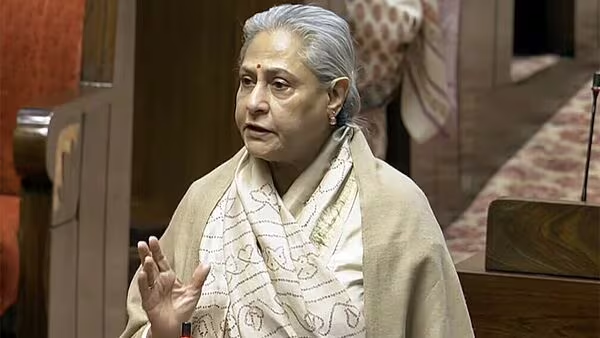Introduction
The Indian Parliament, often a stage for passionate debates and fiery exchanges, witnessed a unique and emotionally charged moment when veteran actress and Samajwadi Party MP Jaya Bachchan strongly rebuked a fellow parliamentarian with the words: “Don’t tell me what to do!” The outburst didn’t just create a stir within the hallowed halls of Parliament—it also ignited a national debate on the symbolism of sindoor (vermilion), gender norms, and the boundaries of personal choice versus societal expectations.
This article explores the full context of the incident, reactions from political and public figures, the cultural significance of sindoor, and the larger conversation it has sparked across India on women’s autonomy and symbolism in public life.
What Happened in Parliament?
On July 29, 2025, during a heated Rajya Sabha session discussing women’s rights and cultural values, a comment directed at Jaya Bachchan about sindoor (a traditional mark worn by many married Hindu women) led to a confrontation. While the specific name of the MP she rebuked hasn’t been confirmed in official records, sources claim that a male MP from the ruling party made a remark implying that women who respect Indian culture should “proudly wear sindoor”.
Jaya Bachchan, known for her assertiveness and dignity in the House, took strong objection to the comment. Rising from her seat, she responded sharply:
“Don’t tell me what to do! Don’t dictate how a woman should behave or what she should wear. This is my choice, not yours or anyone else’s.”
Her statement triggered widespread applause from opposition benches and left the ruling side visibly uncomfortable. The Speaker quickly moved the House to the next agenda item, but the spark had been lit.
Sindoor: A Cultural Symbol With Political Weight
To understand the gravity of this exchange, one must understand what sindoor symbolizes in Indian society.
Sindoor, a red or orange-colored powder applied along the parting of a woman’s hair, traditionally signifies that a woman is married in Hindu custom. It is considered auspicious and symbolizes her role as a wife, often linked with notions of duty, protection, and longevity of her husband.
However, in modern India, this symbol has come under scrutiny. Critics argue that it reinforces patriarchal ideals, placing a woman’s identity in her marital status. Men, by contrast, carry no such visible markers. The implication that a woman must wear sindoor to show respect for culture has sparked debate about freedom of choice, gender equality, and the intrusion of traditional expectations into personal freedoms.
Public Reactions: A Nation Divided
Jaya Bachchan’s outburst immediately went viral on social media, with hashtags like #JayaBachchan #SindoorDebate #WomenInParliament trending on Twitter and Instagram.
Supporters Praise Her Courage
Many social media users, women’s rights activists, and celebrities applauded her for standing up against moral policing:
“Bravo Jaya Bachchan! It’s 2025. Stop telling women how to look, dress, or live!” – @MeeraSinha, Women’s Rights Advocate
“Sindoor is a choice, not a compulsion. Thank you Jaya ma’am for saying what millions feel.” – @RadhikaSharma, Journalist
Several female MPs also came forward to express solidarity. Congress MP Shashi Tharoor tweeted:
“Every woman has the right to choose her expression of identity—religious, cultural, or personal. The House must respect that.”
Critics Accuse Her of Overreacting
However, not everyone saw her response as appropriate. Some conservative commentators accused Jaya Bachchan of using a cultural issue to score political points:
“Why so angry? The MP was only upholding our traditions. Why insult our values in the name of modernity?” – @DeshBhakt_Anil
Some members of the ruling party unofficially remarked that “such aggressive outbursts bring dishonor to the dignity of the House.”
Media Analysis: TV Debates & Editorials
Major news networks picked up the story, giving it prime-time coverage. News18, NDTV, Republic TV, and Times Now ran heated debates:
- NDTV Prime hosted a panel with feminist authors and politicians debating “Is Sindoor a Choice or a Compulsion?”
- Times Now framed it as “Culture vs Modernity: Where Should We Draw the Line?”
- Republic Bharat focused on “Why Jaya Bachchan is Targeting Sanskar (values)?”
Editorials in prominent newspapers offered a mix of perspectives:
- The Hindu wrote: “Jaya Bachchan’s rebuke is not just about sindoor—it’s a cry against centuries of conditioning and silent expectations.”
- The Indian Express highlighted the need to separate religious tradition from legislative discussion, noting, “In a secular democracy, personal symbols should remain personal.”
Jaya Bachchan’s Legacy in Parliament
This is not the first time Jaya Bachchan has made headlines for her fiery speeches and sharp interjections. Over the years, she has spoken candidly on topics ranging from women’s safety to the state of the film industry.
Her presence in the Rajya Sabha, since 2004 (with breaks), has been marked by a blend of grace and gravitas. Despite being soft-spoken off-camera, she has not shied away from confronting political heavyweights when it comes to women’s dignity.
This latest episode reinforces her image as someone who brings both cultural insight and feminist strength to the House.
Beyond Parliament: A Societal Reflection
This incident has reopened a long-standing question in Indian society:
Who gets to decide what cultural symbols mean—and who is bound to follow them?
Is it possible to respect tradition without enforcing it? Can modern Indian women redefine how they wish to express their identity without facing backlash?
For younger women especially, the message from Jaya Bachchan resonated strongly. University students across Delhi, Mumbai, and Bengaluru organized open forums and discussions titled “My Body, My Symbols”, discussing similar issues like mangalsutra, ghoonghat, and karva chauth.
Voices from the Grassroots
In contrast, many women in rural areas still see sindoor as an essential part of their emotional and social life. For them, it’s not about subjugation but respect, pride, and continuity of custom.
Savita Devi, a school teacher in Bihar, said:
“Sindoor is a symbol of love and respect for my husband. I wear it with pride. But I agree it should never be forced on anyone.”
This duality reflects the complexity of Indian society—where tradition and modernity constantly negotiate space.
The Political Fallout
Though the Parliament has moved on, murmurs remain. The ruling party, though not issuing an official statement, reportedly advised its MPs to “refrain from personal or cultural comments that may spark controversy.”
Meanwhile, opposition parties are using this moment to highlight issues of women’s autonomy and moral policing. With elections due in several states later this year, the sindoor debate might just become a metaphor for broader gender rights and freedoms.



